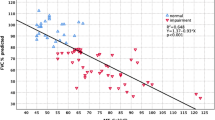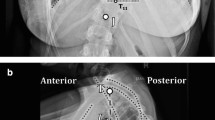Summary
Seventy patients with adolescent idiopathic right thoracic scoliosis had full assessment of their pulmonary function using a computerised pulmonary function system. Their mean age at evaluation was 13.8 years. The following measurements were obtained from anteroposterior and lateral standing and antero-posterior supine bending radiographs: lateral curvature, vertebral rotation, kyphosis, maximum sterno-vertebral distance and apical rib-vertebral angles. Using the above measurements, the flexibility of curve, vertebral rotation and rib-vertebral angle asymmetry were calculated. Patients were classified into three groups on the basis of their predicted vital capacity, to determine whether radiological features of deformity can help identify patients with compromised pulmonary function. The mean Cobb angle and vertebral rotation for the 70 patients were 50° (range 35–100°) and 22° (range 1–44°) respectively. The mean flexibility of curve and vertebral rotation were 52% and 49% respectively. Mean thoracic kyphosis was 25%, ranging from -7 to 55%. Of the patients with Cobb angle less than 90%, 71% had vital capacity less than 80% of predicted values, and of these, 18% had marked compromise of vital capacity (less than 60% of predicted values). Mean values of Cobb angle, vertebral rotational flexibility, kyphosis, rib-vertebral angle asymmetry (in standing as well as supine bending radiographs) differed significantly between patients with more than 80% of predicted vital capacity and those with 60% or less of predicted values. Radiological features indicative of better pulmonary function were: rotational flexibility exceeding 55%, rib-vertebral angle asymmetry (standing) less than 25% and kyphosis greater than 15%. Two deformity parameters—that give a better prediction of pulmonary function than the widely used Cobb angle, vertebral rotational flexibility and rib-vertebral angle asymmetry—were identified in this study.
Similar content being viewed by others
References
Aaro S, Ohlund C (1984) Scoliosis and pulmonary function. Spine 9:220–222
Bergofsky EH, Turino GM, Fishman AP (1959) Cardiorespiratory failure in kyphoscoliosis. Medicine 38:263–317
Cobb JR (1948) Outline for the study of scoliosis. (Instructional course lectures, The American Academy of Orthopedic Surgeons, vol 5). Edwards, Ann Arbor, pp 261–275
Cugell DW, Gantt ME (1960) Thoracic deformity and cardiopulmonary disease. In: Clinical cardiopulmonary physiology, 2nd edn. Grune and Stratton, New York, pp 670–680
Gazioglu K, Goldstein LA, Femi-Pearse D, Yu PN (1968) Pulmonary function in idiopathic scoliosis. Comparative evaluation before and after orthopedic correction. J Bone Joint Surg [Am] 50:1391–1398
Hepper NGG, Black LF, Fowler WS (1965) Relationships of lung volume to height and arm span in normal subjects and in patients with spinal deformity. Am Rev Respir Dis 91:356–362
Kummer F, Meznik F, Pfluger G (1975) Der Einfluss der Kyphose auf die Lungenfunktion von jungen Skoliosepatienten. Z Orthop Ihre Grenzgeb 113:275–279
Levine DB (1979) Pulmonary function in scoliosis. Orthop Clin North Am 10:761–767
Mankin HJ, Graham JJ, Schack J (1964) Cardiopulmonary function in mild and moderate idiopathic scoliosis. J Bone Joint Surg [Am] 46:53–62
Mehta MH (1972) The rib-vertebra angle in the early diagnosis between resolving and progressive infantile scoliosis. J Bone Joint Surg [Br] 54:230–243
Muirhead A, Conner AN (1985) The assessment of lung function in children with scoliosis. J Bone Joint Surg [Br] 67:699–702
Nash CL, Nevins K (1974) A lateral look at pulmonary function in scoliosis. J Bone Joint Surg [Am] 56:440
Perdriolle R (1979) La scoliose: son étude tridimensionelle. Maloine, Paris
Ting EY, Lyons HA (1964) The relation of pressure and volume of the total respiratory system and its components in kyphoscoliosis. Am Rev Respir Dis 89:379–386
Upadhyay SS, Ho EWK, Gunawardene WMS, Leong JCY, Hsu LCS (1993) Changes in residual volume relative to vital capacity and total lung capacity after arthrodesisof the spine in patients who have adolescent idiopathic scoliosis. J Bone Joint Surg [Am] 75:46–52
Weber B, Smith JP, Briscoe WA, Friedman SA, King TKC (1975) Pulmonary function in asymptomatic adolescents with idiopathic scoliosis. Am Rev Respir Dis 111:389–397
Westgate HD (1967) Pulmonary function in scoliosis. Am Rev Respir Dis 96:147
Author information
Authors and Affiliations
Rights and permissions
About this article
Cite this article
Upadhyay, S.S., Mullaji, A.B., Luk, K.D.K. et al. Evaluation of deformities and pulmonary function in adolescent idiopathic right thoracic scoliosis. Eur Spine J 4, 274–279 (1995). https://doi.org/10.1007/BF00301033
Received:
Revised:
Accepted:
Issue Date:
DOI: https://doi.org/10.1007/BF00301033




